-Production-still-1000.jpg)
Sutapa Biswas. Birdsong (production still), 2004. Made possible with the generous support of Iniva, Film and Video Umbrella (London), Grants for National Touring (ACE), AHRC (UK). © Sutapa Biswas. All Rights Reserved, DACS 2020.
by ANNA McNAY
From the first term, of her first year, on her fine art and art history degree at the University of Leeds, in 1981, Sutapa Biswas (b1962, Santiniketan, India) set out to challenge the Eurocentric, colonialist ideas inherent in the teaching. She was lucky in as much as her personal tutor, Griselda Pollock, took her seriously from the outset and engaged with the motivated student. Biswas had come to the UK at a young age, leaving India because of difficult circumstances arising for her father, a Marxist who had been part of the resistance movement against the British Raj, and she had been brought up to speak up, with the self-confidence to present an argument where needed.
While researching her final-year dissertation, titled Black Women Artists: One Hell of a Big Subject, Biswas interviewed Lubaina Himid and Sonia Boyce, later inviting them to speak at the university. She went on to show work, made while still an undergraduate, in the seminal exhibition, The Thin Black Line, curated by Himid at the ICA, comprising works by a radical generation of young female black and Asian artists. Since then, Biswas has gone on to produce work across various mediums – including painting, performance and film – continuing to poetically explore questions of knowledge and power; race, gender and identity; family, migration and history.
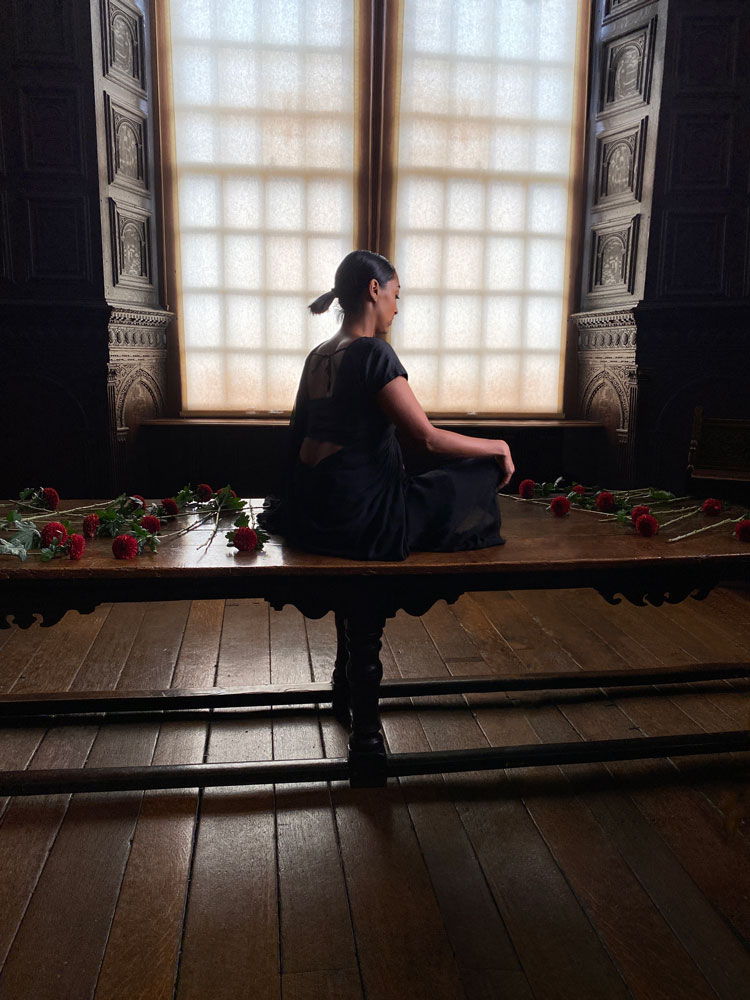
Sutapa Biswas. Lumen (production still), 2020–21. HD video. Co-commissioned by Film and Video Umbrella, Bristol Museum & Art Gallery, Kettle’s Yard, University of Cambridge and BALTIC Centre for Contemporary Art with Art Fund support via Moving Image Fund for Museums. Additional support from Autograph. © Sutapa Biswas. All Rights Reserved,DACS 2021
With two major exhibitions forthcoming, at Kettle’s Yard, Cambridge, and Baltic, Gateshead, Biswas has, despite the restrictions of the pandemic, produced a new semi-fictional film, Lumen, which simultaneously retraces her own steps from Bengal to the UK, and the matrilineal journeys of her mother and grandmothers through two episodes of migration and displacement as a consequence of British colonial rule in India.
Biswas spoke to Studio International via email during the run-up to her exhibitions.
Anna McNay: You started out primarily as a painter. Is this what you studied at Leeds, the Slade and the Royal College of Art? When did you start to branch out into performance, film, photography and installation, and why? Did you feel, as a female artist, you needed to work with these newer mediums, as so many of the feminist artists of the 60s and 70s had?
Sutapa Biswas: It’s true – I did begin my life as an artist absorbed in the processes of drawing and painting. From the early days, I had developed a love of surfaces and mark-making; painting and drawing allowed me to find an imaginative space in which I was psychologically able to immerse myself. With hindsight, perhaps it was a form of escape, but also a context in which, through making, I came closer to redefining my subject – without even fully understanding it, initially. Focused on the feminine space, I was absorbed in creating figurative representations of the female body, often in dance, or compositionally in movement, and primarily in stages of transformation or transition.
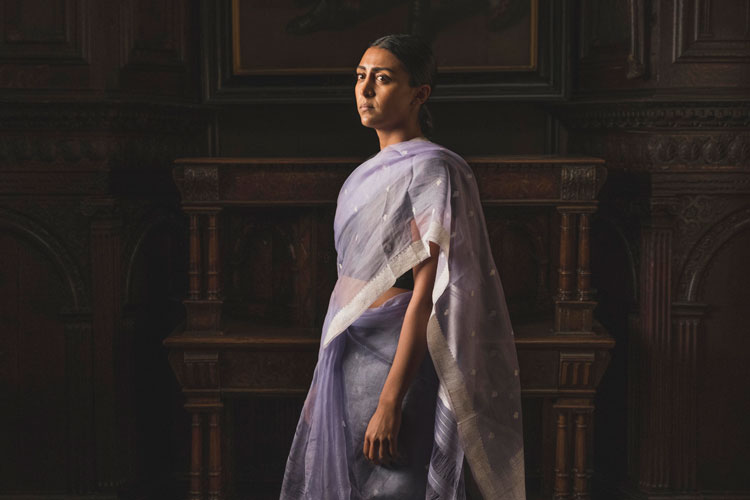
Sutapa Biswas, Lumen, 2021. Production Still - Woman in Blue, #2. Sutapa Biswas © Sutapa Biswas. All rights reserved, DACS 2021.
I became interested in the performative space of art in year one of my undergraduate course at the University of Leeds (1981-82). A visiting tutor, who had no understanding at that time of the significance of visual iconography from India, and how this interfaced with, for example, the colonial history of the British Raj in India, reacted to my expressive, gestural paintings of the female form with hostility. That lack of knowledge took me by surprise. The thing to remember about the fine art and art history course at Leeds in the 70s and 80s is that it was established by the renowned social art historian TJ Clark. It was a brilliant course on many levels, and ahead of all other UK fine art courses, but, surprisingly, there was no engagement with questions of race, gender and class, or the intersections of colonial histories with art history as a discipline. As Griselda Pollock, my personal tutor at that time, has shared on a number of platforms, as a student, I set about challenging this from term one.
I began to research different ways in which I could reclaim my subjects from the kinds of misconceptions surrounding them. I continued to search out ways to celebrate and define my subjects on my own terms through painting, which I have always loved, but also through working with moving image and performance. I returned to one of my earliest memories from childhood, namely going to see classic Indian films, such as those of Satyajit Ray, with my parents in London in the late 60s and early 70s. Aged five or six, I wasn’t old enough to understand the narratives of these films, but the imagery of dark-skinned bodies being projected on a cinematic scale across space and time left an indelible mark. The concepts of temporality, space, and the ways in which scale could play a part in this, were of interest to me.
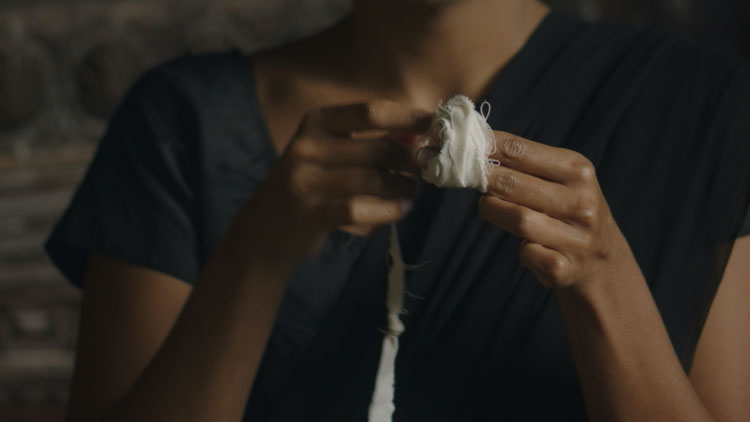
Sutapa Biswas, Lumen, 2021. Film Still – Threads and Knots. Sutapa Biswas © Sutapa Biswas. All rights reserved, DACS 2021.
While performance art wasn’t offered as a subject on the various courses formally taught at Leeds, through conversation with another of my tutors, the brilliant art historian Fred Orton, who lent me many of his personal books, I was introduced to the work of Fluxus and the Happenings. I was immediately hooked. Coincidentally, studying the literature of Bertolt Brecht and Henrik Ibsen (both on our reading lists), as well as researching the role of street theatre, particularly in colonial contexts, the possibilities of using performance as a means of expression to challenge existing normative power structures was of considerable interest to me. I didn’t ever feel that painting, performance and film were unrelated or disconnected from each other; rather, in my world, they were all painterly in terms of how I perceived the connections between them.
AMc: You describe your work as “conceptual”. In what way?
SB: I’m frequently assigned this description of being a “conceptual” artist. Perhaps it’s because of certain qualities in my works, and also because many of my tutors, such as Mary Kelly, Terry Atkinson (of the conceptual artists’ collaboration Art and Language), Susan Hiller and Stuart Brisely, and those to whom I was drawn early on through my own research, such as Nam June Paik, Allan Kaprow, Yoko Ono, George Brecht, David Medalla, Adrian Piper, Gustav Metzger and Joseph Beuys, are known as conceptual artists. It is the case that the starting point of my works is conceptual and idea-driven, but I would say that I am equally led and inspired by formal concerns and processes involved in the making of art, as is the case with Robert Rauschenberg’s series of White Paintings, Howardena Pindell’s paintings, Frank Bowling’s works, Georges Braque’s abstract compositions, JMW Turner’s seascapes, Jan Vermeer’s Dutch interiors and Artemisia Gentileschi’s allegorical paintings. The actual process of making my art is not perfunctory, since the end result is often determined by the process of making itself, and what I discover along the way. In other words, the final aesthetic form of my works is as important to me as the original concepts behind them; both are part of a whole.

Sutapa Biswas, Lumen, 2021. Film Still – Three Women. Sutapa Biswas © Sutapa Biswas. All rights reserved, DACS 2021.
AMc: You draw a lot on the iconography of ancient Hindu mythology. You were born in India, but brought up here in the UK, living mostly in London from the age of four. Did you grow up with these stories, or was this something you deliberately turned to later in life for your work? If so, why?
SB: The iconographic images of ancient goddesses I have drawn on are images of goddesses I grew up with, which were displayed in our home. These were powerful feminine and transgressive presences. There is one particular image of a goddess with eight arms, riding a tiger, which I hung above my bed. She was my muse.
My father was a Marxist and my mother unorthodox. My mother would pray and do puja, for which she kept various Hindu deities in our home, and, even though my father was an atheist, he spoke Sanskrit, and, on occasion, recited the ancient scriptures. But there was, for me, always something about watching my mother in prayer that caught me, as this seemed bound together with her recalling a sense of home in India and “being” in another place and time. Growing up in England, we also attended [the annual Hindu festival] Durga Puja at Belsize Park town hall and other pujas in the homes of family friends. These were key points in our calendar where we were able to be in the company of other Bengalis. Women, children and men from all over London, and many from further afield, dressed in all their finery to celebrate and share stories with each other. There was, for me, something about the sounds, smells and the sights of those events that was intoxicating.

Sutapa Biswas, Lumen, 2021. Film Still - Untitled #1. Sutapa Biswas © Sutapa Biswas. All rights reserved, DACS 2021.
AMc: In the 80s, in particular, you were active at the confluence of black feminism and the black arts movement. Can you say a little more about this? For example, you were part of the landmark exhibition The Thin Black Line, curated by Lubaina Himid, at the ICA in 1985.
SB: From the very beginning of my undergraduate years at Leeds, I was immersed in discussions with my tutors, including Griselda Pollock and Fred Orton, relating to feminism and questions of race, gender and class and the intersections with art history, both because of the surprising absence of this in the broader context of the course curriculum, and because I was already engaged with the histories of imperialism through my parents. My father was a very educated man and had taught at Rabindranath Tagore’s Institute in Santiniketan; he and my mum were born in pre-Independence India in what, at the time, was British India.
In about 1983, I created the performance Kali, the digital video of which is in the Tate Collection. Around the same time, I came across Edward Said’s seminal book Orientalism in my university bookshop and read it alongside The Empire Strikes Back: Race and Racism in 70s Britain, edited by Paul Gilroy, which a peer had mentioned to me. Both these books reinforced the conversations I was already having as an undergraduate student and the work I was making with my tutors and fellow students. It was through reading Said’s book that everything seemed to fall into place. It provided me with a useful lens through which to critique art history.
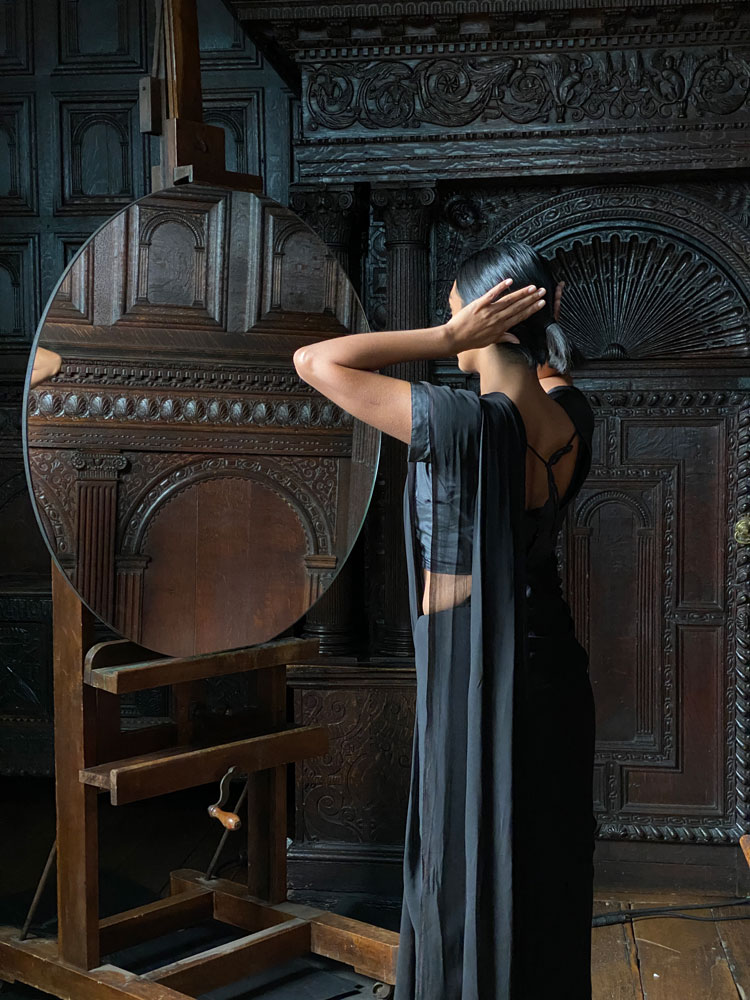
Sutapa Biswas, Lumen, 2020. Film Still - Elbow and Mirror. Single channel digital film Sutapa Biswas © Sutapa Biswas. All rights reserved, DACS 2021.
In the summer term of 1984, our penultimate year, we had to decide on the subject of our final-year dissertation. At that stage, I was interested in either pursuing research on the work of Leonor Fini or black British artists. I knew a bit about Fini, but nothing of the work of other black British artists outside Leeds. I was the first person of colour to have progressed to year three in this department, and the only other fine artists I knew who were black, indigenous or people of colour were three undergraduate students studying fine art at what was then Leeds Polytechnic. It was Fred Orton who steered me towards research on the work of black British artists, and I’m very glad he did. It was in this context, in the late summer of 1984, that I researched an exhibition hosted at Sheffield’s Mappin Art Gallery, titled Into the Open, curated by Pogus Caesar and Lubaina Himid. I attended a talk at the Mappin at which Lubaina was speaking, and this is where we first met. I subsequently interviewed her as part of my dissertation, along with Sonia Boyce, and I organised a talk by them in my department in the spring of 1985. They both viewed the video of my performance Kali (1983-84), as well as the beginnings of Housewives With Steak-Knives (1983-85), when they came to do this talk.
My dissertation, for which I received a first-class honours, was titled Black Women Artists: One Hell of a Big Subject, and it opens with a critique of TJ Clark’s writings about Manet’s Olympia, which incidentally Clark has subsequently revised. I also understand from other students who followed, that Griselda Pollock put my dissertation on to student reading lists. I am probably the first student to have written about the work of Lubaina and Sonia in the context of a dissertation, and I probably own the first recorded interviews with both these artists.
Subsequent to my invitation to Lubaina and Sonia to speak in our department, Lubaina in particular stayed in contact with me and asked me to send her images of the works I presented as part of my final degree show, which I did. This was in view of an exhibition she was in discussions about curating at the ICA. Following my graduation, I received word from Lubaina that several of my works were to be included as part of The Thin Black Line, which was a landmark moment in British art history. After my graduation, Lubaina and I continued to meet on a regular basis in London – often over lunch in South Kensington in a little Italian place called Dino’s. She would frequently tease me because I was carrying some “heavy theory” reading material, such as a copy of Screen magazine, saying: “Just a little light reading, Sutapa?!”
I think it was a combination of my art and my immersion in art history that Lubaina was particularly drawn to. She also generously hosted afternoon events at her then home in Lavender Hill, south London, where she brought together the female artists who would be exhibiting together in The Thin Black Line. She’s not only a brilliant artist, and a great curator, but she was also hugely inspiring to all the black female artists I met at her home. When curating exhibitions here in the UK and in Canada between 1987 and 2001, I was inspired, in part, by Lubaina’s curatorial enthusiasm and practice. A touring exhibition I co-curated between 1987 and 1988, with Sarah Edge and Claire Slattery (both of whom had studied at Leeds), titled Along the Lines of Resistance, brought together the works of female artists across generations and included the work of Lubaina, Maud Sulter, Sonia Boyce, Mona Hatoum, Chila Burman, Anne Tallentire, Leslie Hakim-Dowek and Nina Edge, among many others.
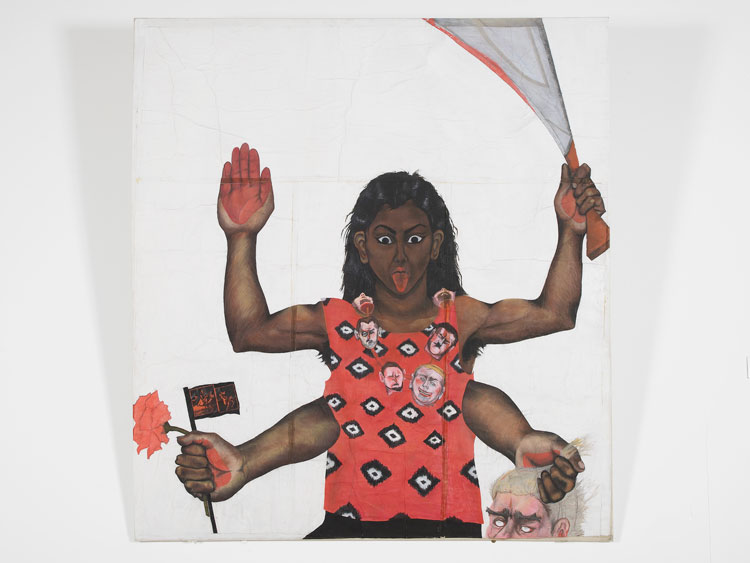
Sutapa Biswas. Housewives with Steak-knives, 1984-85. Oil, acrylic, pastel, pencil, white tape, collage on paper mounted onto stretched canvas, 2450 x 2220mm. © Sutapa Biswas. All rights reserved, DACS/Artimage 2020. Photo: Andy Keate
AMc: Your large, mixed-media work, Housewives With Steak-Knives (1985), designed to sit forward from the wall, is what first catapulted you into the limelight, while still an undergraduate at Leeds. It has been said to predicate “the complexity of signs and referents that continue to characterise [your] artistic career”. Among many other references in the work is one to Artemisia Gentileschi’s Judith Slaying Holofernes. Was this, in part (or indeed in whole!), to deliberately position yourself within a particular lineage of art history? Can you talk us through the imagery and iconographic references a little?
SB: Housewives With Steak-Knives is a work on paper, mounted on to canvas, which, when installed, sits forward from the wall behind by 330mm, which, in effect, activates the painting, and, for me, makes it feel like the sail of a boat. The painting depicts Kali, the Hindu divinity of peace and war, as one of the repeating household goddesses of the South Asian diaspora. Its “being” is perhaps best summarised by the author Ian Baucom, who writes: “The sensuous, muscular strength of this undomesticated wanderer, the glance of menace that she returns to all those presume to run their eyes across her, is complicated, however, by the apparent physical fragility of the piece. Composed of sections of acrylic-, oil-, and pastel-covered paper, which were then glued on canvas, Housewives With Steak-Knives is a self-consuming artefact, a work that to its curators’ horror is persistently dismantling itself as, moment by moment, it sheds its paper skin. But to read this self-defoliating canvas as a fragile work, as one that requires its curators to protect it from itself, is a mistake (and characteristically imperial mistake the British empire built itself on such patronising misunderstandings). For as the canvas unglues itself, it scatters Kali’s body, distributing fragments of this female presence abroad. In doing so, Biswas’s work allegorises the post-imperial scatterings of the women of the subcontinent. But also insists that identity survives dispersal. It reminds us that identity, as Plutarch (an earlier subject of a globalising empire) observed, is something which always encounters itself ‘in the middle of coming to be and passing away … it scatters and again gathers, or rather not again or afterwards but at the same time it comes together and flows away … approaches and departs’.”
The collage of the two reproductions of Gentileschi’s paintings of Judith Beheading Holofernes, taken from Rozsika Parker and Griselda Pollock’s seminal book Old Mistresses, which I was introduced to by Griselda in year one of my undergraduate Theories and Institutions course, adds, I believe, to this interpretation by additionally speaking to the scattering and gathering of women who survive the violence of the patriarchal, imperial order. The white background, which is a reference to Rauschenberg’s White Paintings, is emblematic of this white institutional space.
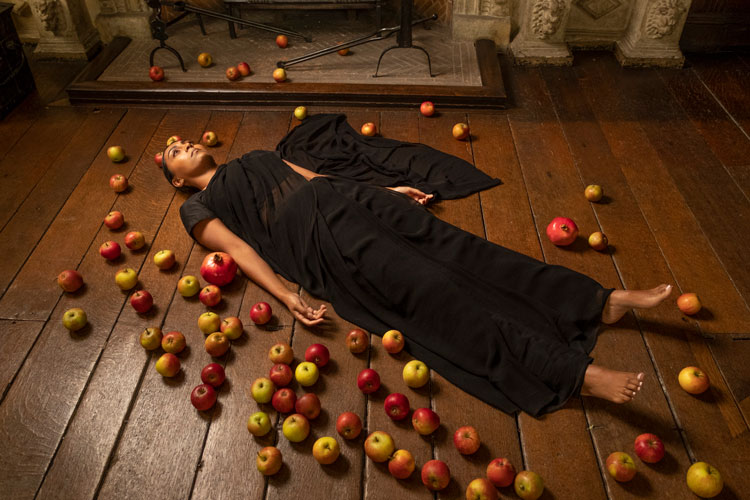
Sutapa Biswas, Lumen, 2021. Production Still - All the Apples. Sutapa Biswas © Sutapa Biswas. All rights reserved, DACS 2021.
AMc: How do you use humour in your work, and why is this important?
SB: The way in which I use humour in my work varies. But, usually, it’s sharp or subtle. I like the concept of the “double-take”. Like a puzzle, it can take you by surprise.
AMc: What about poetry? I know this is a major inspiration for you. You speak of the non-linear poetics of space, time and experience seeping into your psyche.
SB: Poetry was one of my first loves, for there is, of course, in it, a sense of movement through the sound in the speaking aloud of words. I loved words as a young child, and somehow poetry I heard sat somewhere in my body. I have wondered if perhaps this was because my parents often recited poetry at home – both Bengali and English. My parents, educated in what was British India, knew the works of Shakespeare, Keats and many British poets, better, I later discovered, when we came to England, than the parents of my school friends. My mum would often recite Leisure by William Henry Davies, which is a poem about labour and capitalism. Given my mother had such little time for leisure when we arrived in England, her recital was melancholic. The psychic and visceral to-ing and fro-ing of geographic spaces which poetry allows interests me. My parents, growing up British India, could have been imprisoned for speaking their mother tongue. This disenfranchisement from their indigenous culture through language became significant to thinking about the ways in which I could work with language in order to re-centre meaning. In works such as To Kill Two Birds with One Stone (1992-93), the English alphabet becomes the starting point for this.
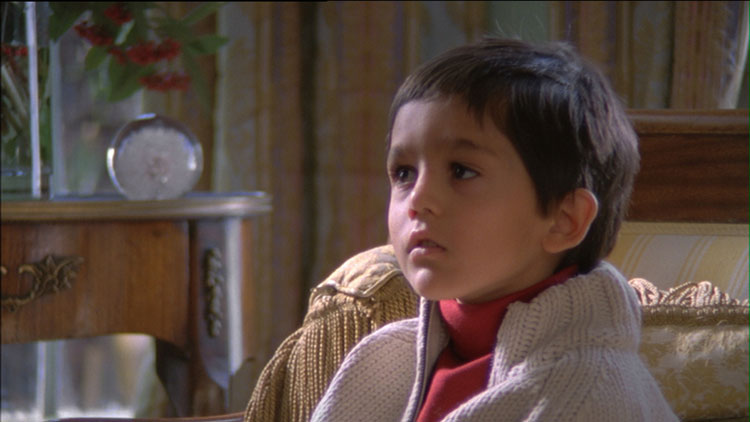
Sutapa Biswas. Birdsong (production still), 2004. 16mm film transferred to DVD, dual screenprojection. Made possible with the generous support of Iniva, Film and Video Umbrella, Arts Council England Grants for National Touring, and Arts and Humanities Research Council. © Sutapa Biswas. All Rights Reserved, DACS 2021
AMc: Time also plays a key role in your film works. How do you play with it and turn it on its head, and what effects do you seek through this?
SB: Yes, time is important to me. I’m interested in the concept of time in relation to history. This is something I have tried to explore through the spatial stories I tell in my works. In working with moving images, time is, of course, implicit in the nature of the form, but I have used particular approaches which, for example, heighten our sense that time is being slowed down, as is the case in Untitled (The Trials and Tribulations of Mickey Baker) (1997), Birdsong (2004) and Magnesium Bird (2004).
AMc: You have mentioned that you were taught at Leeds by Griselda Pollock. How much do you think that influenced the direction of your work and ideas?
SB: Being an undergraduate student of Griselda’s was, of course, formative, as was studying fine art and art history at the University of Leeds between 1981 and 1985 as a whole, in a department wherein theory and studio practice of art was taught through a Marxist, post-structuralist, feminist lens. Griselda was one of the department’s leading scholars alongside Fred Orton, Terry Atkinson and John Tagg, but being a small cohort of students, we were also taught by many visiting artists, professors and scholars, such as Mary Kelly, Laura Mulvey and Art and Language.
Without a doubt, I was very hungry to learn, and being immersed in a course with so much exposure to the discipline of art history, taught from a particular critical perspective, gave me great insight. Nevertheless, it was evident that, in spite of its progressive art historical approach, it was a deeply Eurocentric course, which failed to address a reading of art history and practice through a decolonial lens. To give you an example, two of the first paintings I encountered projected on cinematic scale in the Rupert Beckett Lecture Theatre were Turner’s The Slave Ship (1840) and Manet’s Olympia (1863). As the daughter of Indian parents, born in colonial British India, what was missing in the analysis of these seminal artworks – and also from art historical critiques of that time – was any discussion of the subjects in question in relation to histories of colonialism, race, gender, class and subjectivity. Through a respectful dialogue and exchange with Griselda and some of my other tutors, from year one, term one, I pointed out these glaring absences and demanded art history be rewritten through an anti-colonial lens. My exchanges with Griselda were penned by me at the end of her essay assignments that I submitted to her. This dialogue and exchange became the foundation of an intellectual dialogue and friendship that has now lasted for more than 40 years.
I am aware that it isn’t always the case that a tutor will listen to an undergraduate student in this way, let alone embrace and act on what a student proposes. In this regard, I was fortunate. I would also argue that my tutors were fortunate in that I brought the Eurocentricity of the course they taught to their attention. Speaking up was instinctive to me, because, from early childhood, my father (in particular) had instilled in us children the self-confidence to present an argument where needed. This, too, is unsurprising, because my father had been part of the resistance movement against the British Raj in India, and he had supported the many civil rights movements for racial equality and the abolition of apartheid across the globe.
It’s not irrelevant, either, that, before enrolling as a student, I had lived in a suburb of London where there had been race riots, during which the local community stood up to fascists given permission by the UK Home Office to terrorise a predominantly migrant South Asian and Afro-Caribbean community by marching down the main arterial high street where they lived and bought spices and foods. Oi! bands, which attracted neo-fascist followers, were given permission to play in a local pub, called the Hambrough Tavern. In resistance against the fascists, local community members and anti-fascists burned the tavern down. For weeks after, shop windows and people’s homes were boarded up; the state’s sanctioning of these fascist activities and marches through our community was terrifying.
A combination of life experiences meant that I felt questioning established systems of knowledge and power was as vital as breathing. I think I’ve always been naturally curious. Arriving at university hungry to learn, I was a very good student, attending not only timetabled lectures for courses I was taking in art history, but additional lectures by many other tutors, whose courses I wasn’t taking. For example, I attended all of Fred Orton’s lectures on post-second-world-war American art and the social contexts out of which this grew, which were absolutely brilliant and inspiring. It’s also noteworthy that, in year one, it was mandatory to take a second subject. I took the history and philosophy of science, which segued, I thought, brilliantly, into art history. At that time, Leeds also had a thriving music, club and alternative film scene. Being able to access a broad range of performances and independent films on a regular basis, at the university and other local venues, for pennies, was immensely important. In summary, all of these experiences came together and were formative in the development of my ideas as an artist.
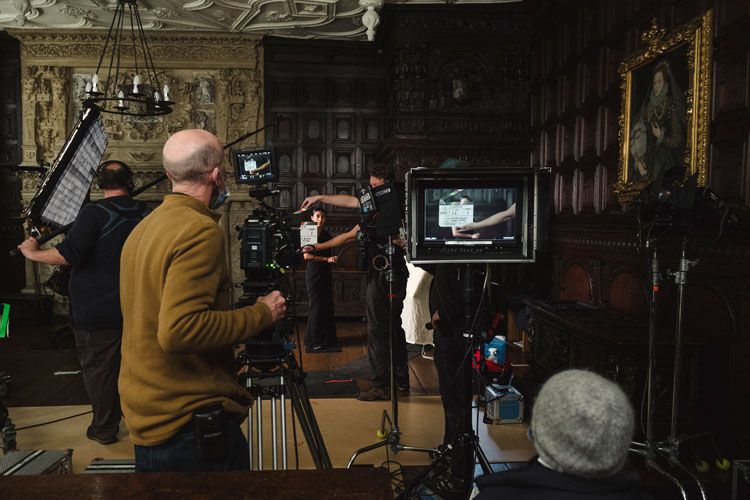
Sutapa Biswas. Lumen (production still), 2020–21. HD video. Co-commissioned by Film and Video Umbrella, Bristol Museum & Art Gallery, Kettle’s Yard and BALTIC Centre for Contemporary Art with Art Fund support via Moving Image Fund for Museums. Additional support from Autograph. Photo: Carlotta Cardana. © Sutapa Biswas. All Rights Reserved, DACS 2021
AMc: You have two major solo exhibitions opening later this year – both delayed by the pandemic. The first will be at Baltic and the second at Kettle’s Yard. Tell me how they came about, and how you have managed to have two in such quick succession. How much were they curated as a pair?
SB: I was approached by both venues independently about three years ago and was put forward for the Freelands Award 2018 as a part of a joint submission by them. Unfortunately, we didn’t win. Regardless, both venues remained committed to realising my solo exhibitions, to supporting my work, and to realising the proposed new ambitious film Lumen (2021), which has been made in collaboration with Film and Video Umbrella (FVU), Bristol Museum & Art Gallery, and with Art Fund support through the Moving Image Fund – a programme made possible thanks to Thomas Dane and a group of private galleries and individuals. It has received additional support from Autograph, London. The whole process of making the film has been really quite extraordinary and wonderful in terms of the number of individuals who recognised its importance. It has been supported by Bristol Film Archives and the Yale Center for British Art, at Yale University, where I was the 2019 fellow and able to undertake key research, which formed a critical part of what underpins the film. All the partners on this project have been absolutely amazing, and it’s been quite a journey together – in a good way!
AMc: How has Covid impacted on your practice, aside from delaying the exhibitions?
SB: Without a doubt, Covid impacted on the production aspects of making the film. Soon after I returned from Yale, I completed the first draft of most of the script. In January 2020, just ahead of the announcement of the pandemic, we fortunately completed 10 full days of filming scenes in India, working with our fabulous Indian production team, Harkat Studios. We were incredibly fortunate for this to have been completed when it was, because filming any later would simply not have been viable due to Covid restrictions. But Covid did still affect us, in that it halted the second part of the film production. I also had to rethink my script. It was originally conceived as a monologue, but also a monologue in which my main actor at Red Lodge, Bristol, would speak the voices of three (or more) characters. I had intended for there to be a second actor whose presence was intended almost as a ghost-like presence or a mirror image (speaking to oneself) and muse all at once. A trichotomous equation of sorts. It sounds complex, but the script, even at that stage, was powerful. The two actors were originally to be choreographed to interact with each other, and the silence of the second actor’s presence was, in some ways, supposed to be almost taunting. When the pandemic was declared, Covid restrictions meant that there could be no physical interactions between the actors in the ways originally conceived. Consequently, I had to reimagine – through set design and via the monologue – how to create the presence of a second actor on set, in the absence of a second actor. I used two mirrors as a device to replicate these presences and “spaces”, or frames of reference, and to formally achieve this alongside the monologue through which many voices speak. Thankfully, we found a brilliant actor – Natasha Patel. She and I worked hard together to achieve the effect that I was looking for. I coached and rehearsed the script with her – predominantly via Zoom. It was challenging, but also fun. We were finally able to rehearse in person at FVU with our marvellous choreographer, Natalie Sloth Richter, and my director of photography, Martin Tester, observing strict Covid guidelines. Everything needed careful planning – even more so under pandemic conditions. It was tough, but what kept the entire crew and team going was a commitment to telling a strong story that needed to be told. There is also a second actor in Lumen who appears in one of the scenes filmed in India prior to the pandemic, and her name is Namrata Sanghani. Namrata is not an actor by training, but, in fact, part of our Indian film crew.
It was a brilliant and memorable experience, with everyone pulling together under what was an incredibly testing set of circumstances due to Covid. The most demanding aspect, in some ways, has been undertaking the post-production of Lumenunder Covid restrictions. For example, it’s quite an achievement describing desired subtle changes in sound design and sound mix in decibels via remote communication (email); everything takes longer because you are unable to sit with another person in a sound editing suite as would ordinarily be the case. But we achieved it nonetheless, and those in our team who have seen the work have felt that it’s incredibly compelling and beautiful.
AMc: What can you share about the film at this stage?
SB: Lumen is a film which, as an idea, had been percolating for more than 30 years, and which charts the matrilineal journeys of my mother and grandmothers through two episodes of migration and displacement as a consequence of British colonial rule in India – first, under partition and, second, as a consequence of difficult circumstances arising for my father in post-independence India. As a work, it draws on a number of influences that are poetic, literary, filmic and art historical. For example, its starting point came from witnessing my mother standing against the light from the window, reading letters from India, when we first arrived in England. On one occasion, she was wearing a fine-thread, blue silk sari. When, aged about five, I first encountered a reproduction of Vermeer’s painting Woman in Blue Reading a Letter (c1663), it evoked my experience of my mother weeping as she read letters from home. This stayed with me, and when, as an undergraduate student, I studied Vermeer’s painting in art history, I came to make a connection not only with the formal aesthetic composition of this work and recalling my mother, but, moreover, with its references to the history of Dutch colonial expansion at the time when it was painted, and to the Dutch East India Company of that period. One of the things Lumen does is to return to the history of European colonialism in India, which lasted for more than 400 years, and look at how devastating the consequences have been.
The film revolves around a monologue delivered by my main actor, who plays the part of three characters. It was written by me in prose form and, in places, feels Shakespearean. I have also been told by those who have viewed the finished work that there are undertones of Sylvia Plath, and that, in places, it also feels like the chorus of a Greek play. Writing the monologue was an intense process because I had to revisit what I imagined was the mindset of my mother at the time when she left India for England, travelling by herself by sea with five young children, travelling to the country of the very people who had violently colonised India for several hundred years. It wasn’t easy.
Formally, Lumen was inspired by a number of films by a range of directors: for example, Satyajit Ray, Ritwik Ghatak, Agnès Varda, Chantal Akerman, Federico Fellini, Maya Deren, Andrei Tarkovsky and Orson Welles. As I have mentioned, as a small child, an early memory includes going to see classic Indian films with my family in London. Seeing the black and brown bodies in front of me, projected on a larger-than-life scale, has always stayed with me. In Lumen, there are formal nods to Ray’s works Pather Panchali (1955) and The Music Room (1958) – in terms of the dialogue and particular filmed sequences. There is also a scene that is a homage to a memorable scene from Tarkovsky’s Ivan’s Childhood (1962). It is a deeply moving and melancholy scene, so much so that the shot reveals my actor to be weeping. There are also references within the film to the work of artists Carolee Schneemann and Shigeko Kubota, which I won’t disclose any more about, as I think these are nuances viewers will hopefully experience when they see the film.
I’m going to borrow [the director of FVU] Steven Bode’s description here, because I think he summarises Lumen very well: “Lumen is the name for a unit of light – a gradient of radiance. It is also an anatomical term for a bodily cavity or conduit, such as an artery, along which blood flows. These two meanings converge in the metaphor of ‘light at the end of a tunnel’; an expression that helps light a way into Sutapa Biswas’s film Lumen, setting the scene for its fluctuations of clarity and darkness, its alternating states of euphoria and trauma, its lurches between poetry and pathology. The film begins with the story of a baby emerging from a womb and ends on a note of departure, with its female protagonist about to embark on a journey across uncharted waters. In between, we are entrusted with a series of intimate scenes from a life, recounted in an episodic monologue whose dramatic ebb and flow is sharply illumined by flashes of memory but indelibly haunted by fears and doubts.
“The journey in question is inspired by the one undertaken, six decades ago, by the Biswas family. A passage from India, an exit precipitated by the artist’s father’s political beliefs, this abrupt uprooting continued to disturb and unsettle her mother. A lament for the sights and sounds of India she and her family had to leave behind on their protracted sea voyage to England, the film is also an angry reproach of centuries of colonial rule, and its implacable incursions on domestic life. Where history has often marginalised the female voice, Biswas reinstates it, not just as mainstay of family and home but as an avatar of social conscience. Mixing archive material and newly filmed footage to embellish its bravura central monologue, Biswas lends this deeply personal narrative a compelling universal resonance. Seen through a glass darkly, Lumen sheds unflinching light on the ripple effects of a complex and turbulent past.”
AMc: Is there always a narrative to your films?
SB: No, not always. For example, there is no narrative in my works Under my Table (2006), 10:30am (2004), or Untitled (The Trials and Tribulations of Mickey Baker) (1997), which is now in the Tate’s Collection. There are only narratives in my moving image works where I feel there needs to be.
AMc: The press release from Kettle’s Yard describes your work as exploring “belonging, beauty and power”. How accurate is this?
SB: The curator and writer Guy Brett has described my works as exploring the “human condition”. In many ways, they are spatial stories. To explore the human condition at any moment is to explore the beauty of everyday living, but also to understand its hardships and challenges. So much of this, I feel, intersects with questions of identity and belonging, and how this in itself is bound together by systems of power and knowledge, which determine so much of regular people’s everyday experience of life.
AMc: What would you say is the key concern of your work, if not one or all of these? I would perhaps have gone with identity, be that in terms of culture, ethnicity or gender, or all three together, including also the “side-effects”, such as racism, misogyny and feminism.
SB: I’m interested in the poetics of life, time and space, and the interface of this with wider systems of power and knowledge. At heart, I’m an artist who loves to read and to occupy, wherever possible, a poetic being and disposition.
AMc: Housewives With Steak-Knives will be on display at Kettle’s Yard, alongside the rarely screened video work Kali (1983-84), which you mentioned earlier and made while still an undergraduate. How do the two works speak to and add to one another?
SB: That’s a great question. Central to both artworks is the mythological tantric goddess Kali, a transgressive figure who represents shakti, the eternal force, and whose name translates to the word “black”. Kali is a black goddess. As artworks, Kali and Housewives With Steak-Knives were begun in about 1983 and born out of my deep immersion in and engagement with art history, and the Eurocentric nature of this discipline, as an undergraduate student. These two key artworks, among others, spoke strongly to each other and challenged these assumptions.
Inspired by my encounter with the Happenings and Fluxus, and following a trip to Paris and Versailles in the summer of 1982 as part of Griselda’s coursework, I began preparations for Kali, first making the puppets that featured in the original performances in November 1983 and January 1984. The second iteration of the performance involves three key performers: myself, Isabelle Tracy and Griselda Pollock. It was recorded in part. The video work Kali (1983-84), which was made subsequently and is a standalone work, is underpinned by an introduction in which I sit in front of my painting of the union jack, Flag, created using the same techniques as Jasper Johns in his encaustic painting, Flag, of the US flag, and speak to the Eurocentric nature of the course on which I was enrolled. The video work includes excerpts from the second iteration of the performance and footage shot subsequent to that, propelled by an elaborate sound design and music score. It is a complex work that slowly unpicks the Eurocentric canon of art history. The head of my central character, Kali, from Housewives With Steak-Knives, is present in the performance and the video work. So the two artworks are, in fact, deeply connected.
-Production-still.jpg)
Sutapa Biswas. Birdsong (production still), 2004. 16mm film transferred onto 2 DVDs. Dual screen projection. Colour, no sound. Duration: 7 minutes 7 seconds. Dimensions: variable. Made possible with the generous support of Iniva, Film and Video Umbrella (London), Grants for National Touring (ACE), AHRC (UK). © Sutapa Biswas. All Rights Reserved, DACS 2020.
AMc: You have made several works referencing the fact that you are a mother. For example, your video Under my Table (2006) takes on your infant son’s perspective as he plays under the table; Birdsong (2004), again seen through his eyes, draws inspiration from his desire to have a horse living with you in your home; and Mata Ne (2015), while less directly personal, captures women speaking about their experiences of life, love and giving birth. How important is being a mother to your career as an artist? Did it interrupt it, hinder it, provide you with inspiration, drain you, or have some other influence?
SB: Housewives With Steak-Knives and Kali were both made in acknowledgment of the strength of women in my extended family circle. As artworks, the central female characters within both pieces sit counter to the stereotypical images of South Asian women, portrayed as meek and as chattel within the mainstream media. By contrast, the role of strong women has always been a presence for me in my life and my art. It’s important to remember that the role of “family” under colonialism has a different set of relations, in that colonialism sought to exploit labour forces, which meant that, under these brutal conditions, families often struggled to survive. In my extended family and personal situation, women had a collective presence that felt matriarchal. Becoming a mother myself, bearing in mind it was not planned, was something of a shock to my system, because suddenly you are juggling huge changes in your personal and professional life. Given society’s patriarchal attitudes to women and to mothers, it wasn’t easy. On a personal level, however, becoming a mother brought something new to me, in that I began to see the world afresh through my child’s eyes. I was unlearning and learning. It was really beautiful and, as an artist, I saw this as a gift. In 1998, when we moved home, my son was about 10 months old. By way of letting friends and associates in my professional world know my change of address, I circulated a letter in which I announced: “Sutapa Biswas is now an artist and mother.” I recall Susan Hiller telling me some time later that she had really enjoyed reading this.
AMc: Is it your son who appears in Birdsong? Was it important to the work to use images of him, rather than of an actor?
SB: Yes, it is my son. Given that the work is based on the first joined-up sentence ever spoken by my son, when he was 18 months old and his voice was coming into this world, it felt important that it was my son. Inspired also by Frantz Fanon’s writings about desire and becoming, it was about this, but inevitably it was also about my relationship as a mother to my son.
AMc: Tell me a little more about the work and the multiple layers of narrative, mythology and iconography. Laura Mulvey has described it as a “Pièta”.
SB: This is another great and difficult question, in that it demands a very considered, detailed response. As much as this work is about becoming and desire, it is also about time, mourning and loss. Loss of innocence, loss of moment. The starting point of this work was, as I say, my son’s first joined-up sentence, in which he said: “I want a horse to live with us … right here in my living room.” It took me right back to two key things: (a) an historical painting I had encountered as an undergraduate, by George Stubbs titled Shooting at Goodwood (1759), which features Lord Holland and Lord Albemarle, in which a young, black, servant tends to the livery while his masters are at play, and (b) Fanon’s writings on race and desire. In a child’s imagination, there is possibility. As we age and progress from childhood into adulthood, desire (more generally) is framed by a whole other set of relations, to do with histories, class, race and gender. I was additionally mindful of the fact that, as my son’s voice was coming into the world, my father was dying of cancer, and we were losing his voice and presence in this world. This work is, therefore, also about time and loss. In fact, the last conversation I had with my father was on the subject of birds and Marcel Proust’s evocations of the passage of time, specifically a woodpigeon’s call cutting through a forest. My work is a silent piece, but titled Birdsong for this reason. It’s a very visceral work, which, as many viewers have mentioned, feels as though there is sound, even though there isn’t.
AMc: Alongside the Kettle’s Yard exhibition, you are partnering with the Red Hen Project in North Cambridge on a series of events about literacy. How and why did this come about, and what will it involve?
SB: Literacy is very important to me. And the telling of stories and sharing of narratives otherwise untold. My works have been called “spatial stories”. If we can encourage children to feel a sense of empowerment through sharing stories, which expand their knowledge of life and this world, then that, to me, is a wonderful thing.
AMc: The Baltic show will include several new works, and some pieces that have never been exhibited in the UK before. How involved were you with the curation? What can you share about the new works?
SB: My exhibition is led by the Baltic curatorial team, with whom I have worked for the past three years, and who have selected works to lend a particular nuance to the overall show. I have been involved to an extent, in the sense that my new film Lumen is a key feature of the exhibition, and Baltic is also keen to include photographic pieces from the making of this work. This exhibition will also include digital video works that have never been seen in the UK, as well as new drawings, which are part of ongoing series – all of which is very exciting for me.
AMc: What are you working on now? Are the exhibitions fully ready to go, or are you still producing work for them?
SB: There are some works still in production for both exhibitions. I’m also working towards a new series of drawings, which will be hosted at the Arnolfini in Bristol later this year. And, of course, I am already gathering thoughts for my next film.
• Sutapa Biswas: Lumen will run from 26 June 2021 to 20 March 2022 at Baltic, Gateshead.
• Sutapa Biswas will run from 16 October 2021 to 30 January 2022 at Kettle’s Yard, Cambridge.